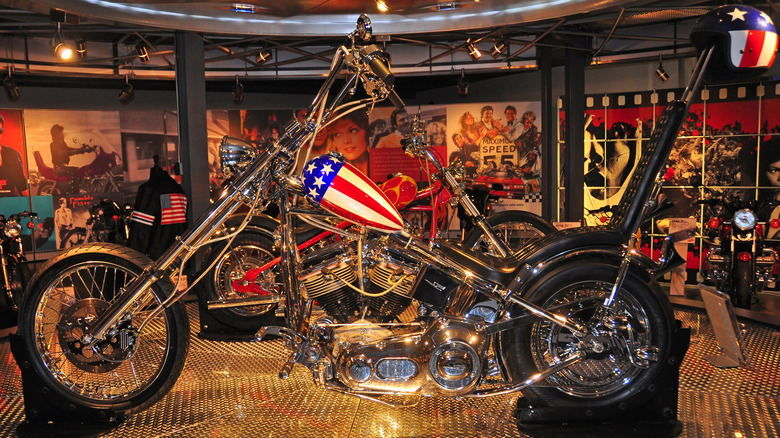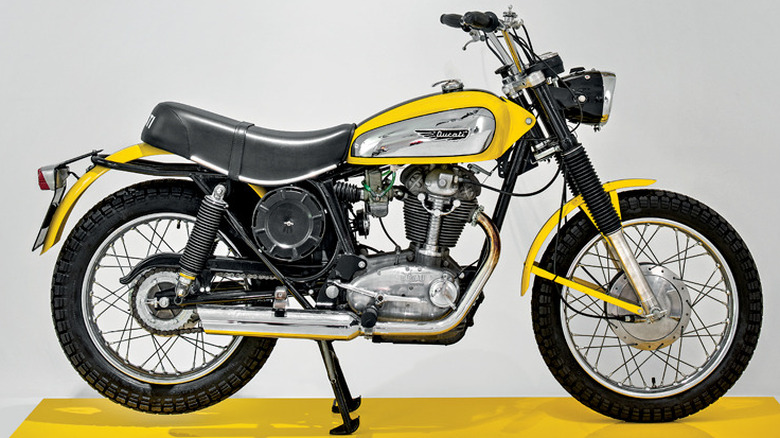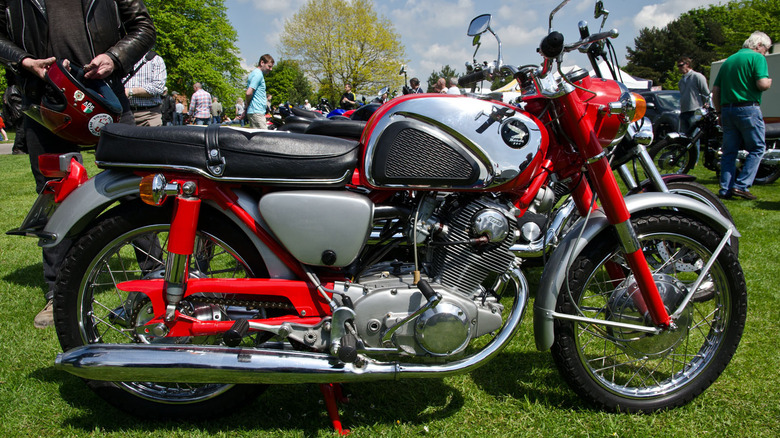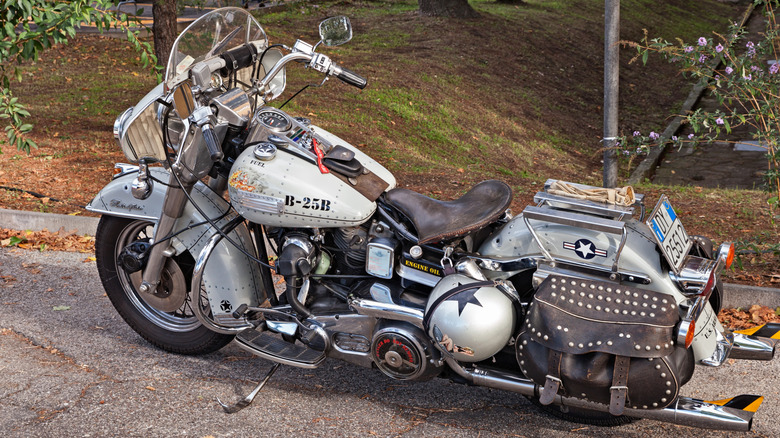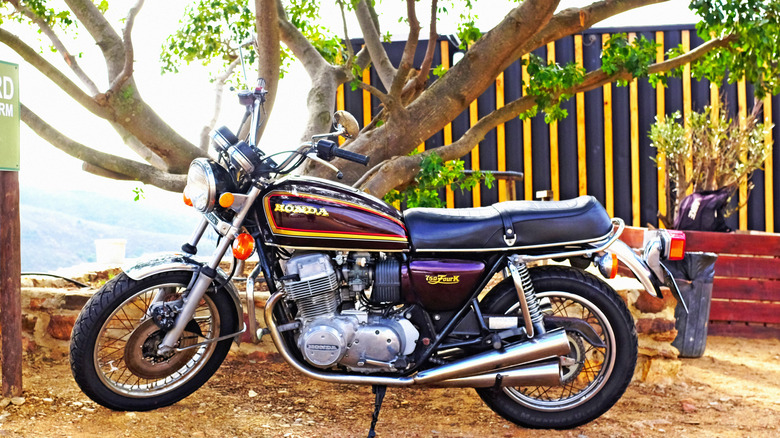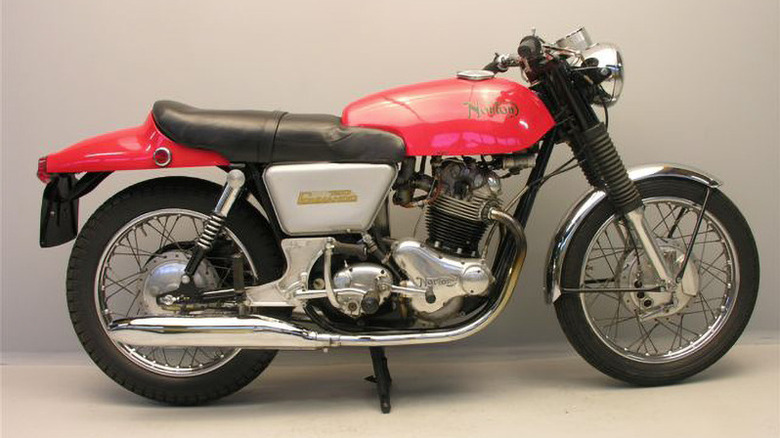5 Of The Most Iconic Motorcycles From The 1960s
The 1960s were a transformative decade across the globe. The brewing Cold War between the United States and the Soviet Union prompted East German authorities to build a wall dividing the nation's capital city in 1961, while conflicts in Vietnam and the looming specter of nuclear war gave birth to a worldwide hippie counterculture. This rebelliousness helped popularize motorcycles around the world, and in 1969 the film "Easy Rider" brought those two themes together. Along with human stars Peter Fonda, Jack Nicholson, and Dennis Hopper, "Easy Rider" featured an array of hand-built choppers based on Harley-Davidson models.
Hopper and Fonda went to bike builder Clifford Vaughs with their idea for the movie, and Vaughs told NPR he was in from the start. "I can build whatever we need for the film right here at my place," he recalls telling the two young actors. A bike rumored to be the original from the film sold for $1.35 million in 2014, making it one of the most valuable classic Harleys ever. That "Captain America" chopper ridden by Fonda's character might be the single most iconic motorcycle of the tumultuous decade, but there are plenty of factory models that were of great importance to the industry, motorcycle culture, or both.
The Ducati Scrambler was a dual-sport legend
Ducati had a little over a decade of motorcycle production behind it when the Scrambler joined its lineup in 1962. It was based on a concept dreamed up by Joseph Berliner, who, at the time, was importing Ducati bikes to the United States. Berliner wanted a versatile bike he could sell to younger riders, and Ducati obliged him with the dual-sport Scrambler. The original model had a 249cc. 18 horsepower engine, which was enough to get the 320-pound bike to over 100 miles per hour if the sprocket was swapped out.
The Scrambler offered a sturdy frame and balanced riding position, and the model evolved steadily throughout the '60s. The Scrambler 450, which had a 436cc engine putting out 27 horsepower, came out in 1969. The original Scrambler lasted through 1974, then was discontinued while Ducati built its racing and superbike pedigrees. Ducati brought the Scrambler back in 2015, capitalizing on the original's historical importance and ability to attract buyers from both sides of the Atlantic.
A Honda CB77 Super Hawk went to the Smithsonian
The year before "Easy Rider" brought outlaw motorcycle counterculture to the big screen, Robert Pirsig took his Honda CB77 Super Hawk on a trip from Minnesota to California with his son aboard. Pirsig chronicled the trip and the constant attention he paid to the bike while on the road in his 1974 book, "Zen and the Art of Motorcycle Maintenance." The book had been rejected more than 100 times before Pirsig found a publisher, but it immediately resonated with a wide audience. When the CB77 first became available to American buyers in 1961, its 305cc engine was the largest in Honda's lineup.
The sport model was bookended by the touring CA77 and scrambler CL77 in Honda's lineup, and the two-cylinder engine on all three models had a healthy redline of 9,000 RPM. Honda made about a quarter of a million of these motors, and they have a reputation as dependable workhorses. The Super Hawk stayed in Honda's lineup nearly to the end of the decade, but Pirsig's book immortalized it forever. After his death in 2017, his wife Wendy donated his bike — along with some of his gear from the trip and a signed first edition of the book — to the Smithsonian's National Museum of American History.
The Harley-Davidson Electra Glide was a police favorite
Harley-Davidson has grown from its humble Milwaukee roots more than a century ago into a global corporate powerhouse. Plenty of Harley-Davidson motorcycles have had prominent roles on television or in movies, and at least one model got its name on the a film's title screen. That was for the 1973 crime thriller "Electra Glide in Blue," which starred Robert Blake as Arizona motorcycle cop John Wintergreen and a Harley-Davidson Electra-Glide as his ride.
The Electra Glide was an updated version of the Duo Glide, taking its name from the electric starter that was added on in 1965. Harley's engineers had to redesign the frame to accommodate a 12-volt battery, the oil tank was moved to the left side, and the familiar "batwing" fairing appeared on the fork. The original Electra-Glide also had a spring-mounted seat, lockable hard saddlebags, and a windscreen that made it a favorite of police forces nationwide. In 1966, Harley replaced the aging panhead V-twin with the new shovelhead, bumping output from 54 to 60 horsepower and changing the Electra-Glide's model designation from FL to FLH.
The model was updated a few times throughout the '70s,, and the Electra Glide has been immortalized in hundreds of Hollywood productions, usually as a police bike. You can see them in '"The Outsiders" and the first installment in the "Ghostbusters" film series, as well as on the TV classic "Kojak."
The Honda CB750 is one of the industry's most important models
No discussion of the most important bikes of the '60s would be complete without mentioning the Honda CB750. It's one of the models that pushed Honda to the top of our rankings of the world's best motorcycle makers, and helped kick-start the superbike era after its introduction in 1969. It wasn't the world's first production four-cylinder motorcycle, but the CB750 transformed an industry dominated by engines with one, two, or three cylinders. Honda's 736cc four was more powerful and reliable than the three-bangers made popular by British bike manufacturers, and Honda mounted a 300-millimeter stainless steel disc brake on the front wheel to help rein in the CB750's 67 horses.
The CB750 went through several updates in the first few years of the '70s, and had to face off against new competition when Kawasaki unveiled the Z1 in 1973. Honda's constant tweaks helped the CB750 win honors as the top-selling bike in the U.S. in 1974 at around 60,000 units. It's an undeniably influential model, and made SlashGear's list of Honda's best bikes of all time. We're not the only ones that recognize its significance, though. Silodrome's Ben Branch called it "quite easily one of the top 10 most important motorcycle models of the 20th century," and Ian Falloon of Australia's MC News noted that "it immediately became the standard against which all others were judged."
The Norton Commando helped save the company near the end of the '60s
Like the CB750, the Norton Commando made its mark on the decade despite a late introduction. The company unveiled it in the fall of 1967 in London after a hasty development period of under three months. Norton was in financial trouble at the time, which one of the Commando's designers said was the cause of that urgency. Engineer Bob Trigg told The Vintagent, "We were would told that if we didn't have a new bike at Earls Court that year, the company would go bust."
The design consultants, Wolff Ohlins came up with the quirky fastback seat, tank, and tail design, and Trigg said the collaboration was critical. "We all worked on it as a good team, and we couldn't have done it any other way."
Although the Commando was fast and smooth, the non-traditional styling made it initially a poor performer on the market. The 745cc parallel-twin engine sent 58 horsepower to the rear wheel via a four-speed gearbox and chain drive, and the Commando monopolized the Motor Cycle News "Machine of the Year" award from 1968 through 1972. You can still snap up one of these classics for under $15,000, although they don't come up for sale very often.
